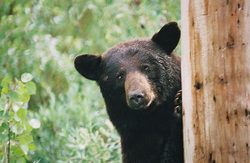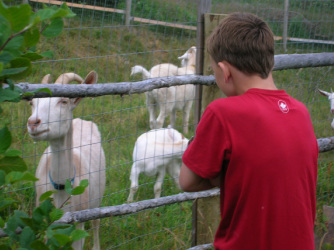
Rusty is soft and sweet. He gently rolls onto his back when he realizes you’re up for giving him some love. As for his manners—I’m just going to put it out there—we could see right away this guy was, ahem, a tad better behaved than our much-loved Zoe.
The only shocker came (still comes) looking at his ribcage. Past that strong Lab face and glossy coat, there’s a cruel count-every-rib gauntness. And just when you wouldn’t think Rusty could get any thinner, there’s just empty space where he should have a waist.
Before we knew it, we had Rusty in the hatch of our car. And quicker than you can snap your fingers, we are dog owners again. Having raised a breeder puppy before, Rusty takes some getting used to. There are all these missing pieces to the puzzle. It’s crazy. We know so little about him except that he’s come from a shelter in Ohio, is maybe 7 or 8, has been well-trained, and did well in foster care.
Thus far, Rusty’s settled in with a quiet thump and quickly accumulated a list of good points: He’s an easy guy in the house. No chewing furniture. No stealing or begging for food. He enjoys the backyard without a bark or a whimper. This big boy is perfectly content to sleep on the floor—and wouldn’t dream of claiming the couch, or the humans’ beds. And best, he’s been greeting neighbours and Zachary’s friends with just the right soupcon of friendly tail wagging, lowering his handsome head ever so slightly to receive hello pats.
Seems the only thing we need to train him on is his exuberance upon meeting other dogs. When it comes to other canines, Rusty is ready to party. I’m suspecting he was a country dog, or maybe a hunting dog, so needs some schooling on restrained city-dog hellos.
But the big job now is to feed him. And here I’m having fun and seeing little hints of what might have been. Unbelievably, for such an emaciated dog, Rusty is choosy. We’ve been offering him bowlfuls from the monster sack of kibble his foster family gave us, and hungry as he must be, he’ll politely walk away. Out of curiosity yesterday I threw some avocado in his bowl. Yum, he said. Then we tried some cans we still had of Zoe’s premium fish-oil laced lamb and rice. Double-yum. Similarly, he delicately polished off slices of bacon, oatmeal, and butter. Real food, man, he’s saying. I like real food.
When our family chose “rescue” over pedigree, we landed squarely in the middle of a growing North American trend. According to Linda Lord, a professor of veterinary medicine in Rusty’s home state of Ohio, “In general, across the country, the adoption rates have gone up.” And stats from the Humane Society of the United States and the A.S.P.C.A show this trend is making a huge difference in kill statistics. Today in the U.S., an estimated “3 million and 4 million unwanted dogs and cats are euthanized annually. Forty years ago, an estimated 20 million annually were euthanized.”
It’s not all rainbows and puppy licks of course. Rescue dogs aren’t for everyone. I just read today that almost half of rescue dogs get returned right back to foster care. Even a sweet dog like Rusty was just returned by one family last weekend—in that case, the family’s cats scratched and hissed ‘no deal’. But by applying our previous experience as dog owners and choosing a dog that seems suited to us, we’re hoping we’ll have better luck. For his part, Rusty is enjoying some peace and quiet and I think he’s getting more comfortable. I just saw his eye close.
More:
- “Kill rates vary widely at Ohio dog shelters”. An article from The Columbus Dispatch on the patchwork condition of Ohio’s animal shelter and adoption system, and the rising popularity of “rescue” animals.
- “Ad Featuring Singer Proves Bonanza for the A.S.P.C.A.” New York Times, December 25, 2008. Great article about how those ASPCA ads by Canadian singer Sarah McLachlin made a huge difference.
- “To the Rescue. Nearly 20% of dogs and cats are adopted. Here's how to streamline your search for the perfect pet.” Prevention, November 2011.



 RSS Feed
RSS Feed
